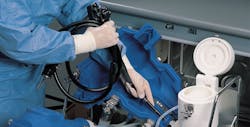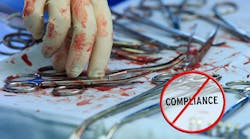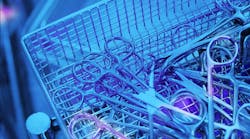What are some useful tips on how to inspect cleaned endoscopic devices before they are placed into the high-level disinfection unit or sterilizer? Sterile processing experts from providers and suppliers share their insights.
A 10X magnifying glass can be used to inspect the scope for visible debris and soil. To inspect the presence of bacteria beyond what can be seen by the naked eye, consider implementing a cleaning monitoring program using rapid cleanliness indicators, or consider using a borescope for visual inspection of internal channels. It is also recommended to implement a checklist to document that the cleaning process has been performed correctly. Software is available that document, track and trend the efficacy of manual cleaning.
Grace Thornhill, Ph.D., Infection Prevention Fellow, Boston Scientific Corp.
- Ensure the visible areas of the endoscope are free from cracks, scratches, or debris. Microorganisms located within damaged areas can evade contact with reprocessing tools (i.e., brushes) and detergents/chemicals.
- Ensure all reprocessing accessories used are free from cracks, scratches, or debris. Microorganisms located within damaged areas can evade contact with reprocessing tools (i.e., brushes) and detergents/chemicals. Damage to accessories may impede proper reprocessing of the endoscope.
- Use magnification to inspect the endoscope and endoscope accessories to ensure they are free from cracks, scratches, or debris. This will help identify damage in harder-to-see areas, such as the distal tip.
- Use a boroscope to inspect lumens of endoscopes. This tool allows the user to visually inspect endoscope channels for presence of debris or damage.
- Perform cleaning verification testing to provide greater confidence that manual cleaning was effective. Methods of manual cleaning verification include ATP and bioburden testing.
Melinda Benedict, CFER, Manager, Infection Control Program, Olympus America Inc.
- Complete cleaning verification testing after manual cleaning to ensure acceptable removal of clinical soil on every endoscope, every time.
- Ensure that cleaning accessories are clean for each use. If they are single-use do not reuse. If they are reusable, follow the manufacturer’s recommendation on inspection and disinfection. Ideally, all reusable cleaning accessories should be disinfected between uses and inspected before use to ensure they are not damaged. Damaged accessories can be less effective and may even damage the endoscopes.
- Ensure that the disinfection cycle is completed according to the schedule recommended by the AER manufacturer.
- Carefully inspect for any damage, even if the endoscope passes the leak test. Damage to endoscopes or processing equipment provides area for microbes to collect and increases the difficulty to clean, disinfect or sterilize.
Janet Prust, 3M Health CareJanet Prust, Director, Global Scientific Marketing and Education, 3M Health Care
There is little doubt that the most important aspect of sterilization is preparation of the device to be sterilized. An important point that cannot be stated often enough is that a device cannot be sterilized unless it is first properly cleaned since any bioburden inadvertently left behind by improper cleaning practices can potentially cause patient harm. Rigid and flexible endoscopes require special handling and cleaning to ensure successful sterilization, and the manufacturer’s guidelines for both cleaning and sterilization must be followed.
The ECRI Institute report, “Top 10 Health Technology Hazards for 2017” also highlighted the critical nature of pre-cleaning instruments immediately after use at the point of care, noting that doing so makes the disinfection and sterilization steps easier and more effective.
It is also important to open and close the jaws of forceps to ensure proper function, and to use an eye loupe or camera to inspect the delicate jaws and crevices of instruments to check for flaws or residues. Routine checks of reusable scissors and trocars for sharpness can also help the hospital avoid the high cost of turning to disposable items as alternatives. This must be done each time the set is sent for reprocessing.
Crit Fisher, Director, Field Ops, Protection1, KARL STORZ Endoscopy-America Inc.
Perform a carefully executed and complete visual inspection of the scope prior to sterilization. Having detailed knowledge of the individual component parts and their functionality collectively for a given scope provides the necessary basis for a proper scope inspection prior to patient use.
The endoscopic device needs to be tracked electronically and consistently on the number of uses and assigned to an appropriate comprehensive inspection process that is documented in the scopes history.
Personnel working with endoscopes need to be fully trained, specifically including the most obvious and most obscure aspects of failing or passing a scope before that scope can continue to the sterilization phase and ultimate use on patient. This additional part of the knowledge base at some facilities does not include a robust preventive maintenance inspection process. This deficit contributes to the endoscope not being flagged for maintenance and/or repaired until a leak failure or operational failure while in use in the OR.
Scope issues need to be tracked and that information must be available for analysis to the facility for quality assurance. This information should include but not be limited to the number of uses, frequency of use, surgeon, detailed repair history and preventive maintenance inspection history.
Jon Whinnery, CHL, CSPDT, CRCST, CIS, CNA, Operations Manager, Paces MedEquip LLC
- Follow the instructions for use for each device provided by the manufacturer.
- Ensure that the staff understand that the device might be used for them during a procedure and engage them in developing assessment criteria for “gold standard device assessment.”
- Engage stakeholders and build audit tools, procedures and overarching procedures that are frequently reviewed, authenticated and modified as necessary and upon purchase of new devices or equipment used in tandem with the endoscopic devices.
- Develop “Gold Standard” cleaning teams who are deputized by the stakeholder team and provide feedback to the stakeholder team frequently.
- Provide weekly re-education opportunities and engage the staff in developing the core curriculum from their best “lessons learned.”
Melanie Miller, Healthcare Value Management Experts Inc.
In all honesty, we really can’t call these examples “useful tips” anymore and should be calling them requirements at this point. It is necessary to ensure endoscopes have been properly and effectively cleaned before placing them into the high-level disinfection unit or sterilizer. It should be required that every endoscope that has undergone post-procedure or point-of-use cleaning and manual cleaning be evaluated for efficacy in removing all soil. This is actually quite easy to accomplish by ways of indication testing, visual evaluation, and proper and ongoing training. The market is full of indication testing tools such as rapid indicators that allow any facility to test an endoscope for residual organic material after cleaning processes have been performed. There are also magnification tools, such as micro-borescopes that enable an individual to visually inspect the internal structure of working channels where debris can be hidden. In the current marketplace, the need for these tools and the training on cleaning are more important and necessary than ever before.
Brianne Flesher, CFER, Product Manager, Mobile Instrument Service & Repair, Flexible Endoscope Repair Division
- Hold healthcare facilities to the same standards as manufacturers.
- Healthcare facilities need to validate cleaning processes to demonstrate that the manufacturer’s IFU works at the facility. This is called Product Quality Assurance Testing in ANSI/AAMI ST79 and in the new quality standard ANSI/AAMI ST90. This should be done in the same way that manufacturers validate these processes. The manufacturer’s IFU is at best a guideline. The healthcare facility needs to provide objective evidence that the process identified in the manufacturer’s IFU works at their facility.
- Healthcare facilities need to validate their sterilization processes. This is PQA testing.
- Healthcare facilities need to develop comprehensive cleaning inspection programs for all devices that are processed at the HCF. This should include testing for residuals, (e.g., protein and hemoglobin).
- Healthcare facilities need to develop comprehensive testing programs for all equipment used in reprocessing.
- A comprehensive quality program is needed which requires reporting of any dirty medical device that makes it to the point of use. Reporting of these events should be required by State health departments and CMS. These reports should be reviewed whenever an inspection occurs. These are serious events and need to be identified and quantified so that comprehensive solutions can be developed to address these problems.
- Manufacturers need to work with healthcare facilities to teach them how to do these things.
- How to develop and write a validation protocol.
- How to conduct validation testing.
- How to interpret/analyze results.
- How to write a validation report.
- When and under what circumstances devices or processes need to be revalidated.
- States (or healthcare facilities) need to require reprocessing technicians to be certified.
- States (or healthcare facilities) need to require academic credentials/education before reprocessing technicians are hired. External training is required for other allied healthcare professionals, (e.g., surgical technologists).
- Ongoing continuing education needs to be required as part of certification or as part of licensing by the states.
- Healthcare facilities need to be held to the standard that we do have and (preferably to the same standards as industry). Failure to meet the standards should result in disciplinary action. This can include:
- observations during survey for compliance
- warning letters
- structured and frequent surveys to ensure compliance
- disciplinary action, which can include civil actions, (e.g. fines, should be taken for continued non-compliance).
- Manufacturers need to consider cleaning and sterilization during device design.
- Devices need to be designed that can be disassembled for easy cleaning.
- Training needs to be provided to reprocessing technicians so they have the skills needed to reprocess complex devices.
- Manufacturers need to adhere to the FDA Guidance Document Reprocessing Medical Devices in Health Care Settings:
Validation Methods and Labeling — Guidance for Industry and Food and Drug Administration Staff.§ Including validation of the IFU for understanding and ability of people to perform the procedure as detailed in the instructions
- Improvements need to be made in reprocessing equipment. All automated washers need to adhere to applicable ISO standards. Manufacturers of equipment need to work with healthcare facilities to ensure cleaning and sterilization equipment is subjected to comprehensive, installation qualification, operational qualification and performance qualification.
- Academic credentials need to be developed for reprocessing technicians and people who want to enter this field need to be held to the attending and successfully completing credentialed programs.
- Reprocessing technicians need increased understanding of the science behind cleaning and sterilization.
- Formal course work in microbiology, chemistry and physics should be required.
- Reprocessing technicians need to be recognized for the knowledge and skills that are required to do the job. Recognition should include pay commensurate with skills and knowledge required.
Donna Swenson, President and CEO, SterileProcessing Quality Services Inc.
Use good lighting and visual inspection with magnifying capabilities to show areas that were improperly cleaned. The use of internal inspection scopes will help personnel in visualizing inner lumens for cleanliness. For obscure issues meticulous documentation is important in ensuring that all steps have been taken in the cleaning process. The use of validation devices, such as those that test for adenosine triphosphate (ATP), are an excellent means of ensuring that scopes are clean before sterilization or high-level disinfection.
Robert B. Dybec, RN, CPSN, CNOR, OperatingRoom Nurse Manager at Winthrop-University Hospital, Mineola, NY,and a clinical consultant, Ruhof Corp.
- Use a smaller scope to look for visible debris to ensure appropriate cleaning.
- Use an external indicator to review casing to ensure no breaks whereby debris may be present or damage may occur during processing.
Jean Sargent, President, Sargent Healthcare Strategies
- SGNA Standards of Infection Control in Reprocessing of Flexible Gastrointestinal Endoscopes
- “Reported gastrointestinal endoscope reprocessing lapses: The tip of the iceberg,” 2013
American Journal of Infection Control - Certification Board for Sterile Processing and Distribution (CBSPD)
- Scope Manufacturer’s guidelines
Alicia Titzmann, Senior Clinical Operations Consultant, Cardinal Health
Clearly, all scopes need to be cleaned and inspected before they are placed into an AER or sterilizer. Some scopes, such as ECRP and EUS scopes are more complex and present additional cleaning challenges. Some useful tips on how you may inspect your cleaned endoscopic devices to spot warning signs before you place them into an HLD unit or sterilizer are:
- Look for a discolored glue seal around the lenses, (turning from black to a lighter black/gray) as this can be an indication that the glue is drying out and can easily chip or crack, creating an opening for bacteria.
- Look for the same indication on the bending rubber (proximal and distal) glue bands and or any discoloration.
- Under magnification, look for very tiny pin holes in the glue seals around the lenses on the distal tip of the scope (looks like pitting).
- Under magnification, look for tiny chips or cracks in the C-cover, lenses.
- Use a borescope to inspect the scope lumens for debris, staining, etching and discoloration.
- Under magnification, inspect all areas that look worn. Scratches and scuffs in the insertion tube and light guide tube may harbor bacteria.
Chris Antonucci, Director of Marketing, STERIS Infection Prevention Technologies
Read on…





